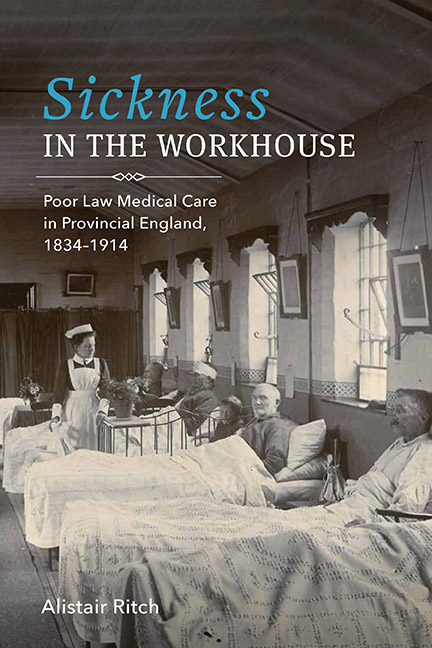Book contents
- Frontmatter
- Dedication
- Contents
- List of Tables
- Acknowledgments
- Introduction: Pauperism and Sickness
- 1 From Acute Illness to Chronic Disability
- 2 Segregating Fever Patients
- 3 Controlling Disorderly Behavior
- 4 Day-to-day Doctoring
- 5 Medical Therapies
- 6 Poor Law Nursing
- 7 “Every Care and Kindness”: The Standard of Workhouse Medicine
- Appendix A Prevalence of Selected Infectious Diseases in Birmingham Workhouse on the Last Day of the First Week of Each Quarter for the Years 1877–80 and 1894–1911
- Appendix B Medical Relief in Birmingham Workhouse for Selected Weeks, 1851–56
- Appendix C List of Drugs Kept in the Wards of Birmingham Infirmary in 1896
- Appendix D Pauperism Rates and Institutionalization Rates for Birmingham Parish, Wolverhampton Union, and England and Wales, 1840–1911
- Notes
- Bibliography
- Index
1 - From Acute Illness to Chronic Disability
Published online by Cambridge University Press: 21 March 2020
- Frontmatter
- Dedication
- Contents
- List of Tables
- Acknowledgments
- Introduction: Pauperism and Sickness
- 1 From Acute Illness to Chronic Disability
- 2 Segregating Fever Patients
- 3 Controlling Disorderly Behavior
- 4 Day-to-day Doctoring
- 5 Medical Therapies
- 6 Poor Law Nursing
- 7 “Every Care and Kindness”: The Standard of Workhouse Medicine
- Appendix A Prevalence of Selected Infectious Diseases in Birmingham Workhouse on the Last Day of the First Week of Each Quarter for the Years 1877–80 and 1894–1911
- Appendix B Medical Relief in Birmingham Workhouse for Selected Weeks, 1851–56
- Appendix C List of Drugs Kept in the Wards of Birmingham Infirmary in 1896
- Appendix D Pauperism Rates and Institutionalization Rates for Birmingham Parish, Wolverhampton Union, and England and Wales, 1840–1911
- Notes
- Bibliography
- Index
Summary
The prevailing picture of the Victorian workhouse infirmary is of an institution filled with inmates suffering from chronic diseases and disabilities, a place where almost no treatment of acute illness was practiced. According to welfare historian Samantha Shave, it was the most reviled institution among the British working class. However, we have already seen in relation to the illness of Anne Walford at the beginning of the introduction that it was regarded as an appropriate setting for acutely ill paupers in Wolverhampton in the first decade after the New Poor Law, and this chapter will provide further evidence to demonstrate that acute care was an integral part of workhouse medical officers’ work. It will also provide an in-depth analysis of the characteristics of those inmates classified as “aged and infirm,” who did make up the majority of patients, but who have been largely neglected within the historiography of the poor laws.
Sick inmates formed a substantial group within the workhouse population, the proportion increasing from 10 percent in 1843 to between 34 percent and 48 percent in the mid- to late 1860s, with the higher figure in London and the lower in provincial workhouses. By the end of our period of study, 32 percent of inmates of poor law institutions in England and Wales were accommodated in sick wards or separate infirmaries. Illness and injury accounted for a substantial proportion of admissions to workhouses; for instance 62 percent of adult males and almost 44 percent of adult females were admitted to Medway Union workhouse between 1876 and 1881 because of sickness. Workhouses had begun to adopt the role of hospitals by 1870 and those in large towns became transformed into “infirmaries for the sick,” widely regarded as the first public hospitals. By 1891, the public sector provided about 83,000 beds, compared with only 43,000 by voluntary hospitals. The greater number of sick inmates in poor law infirmaries resulted from the recognition of the benefits of institutional medical care for those who could not be cared for at home, the poor state of health of many paupers prior to illness, and the growing popularity of hospitals among the poor. The policies of the central authority also contributed to the increasing admission of sick paupers.
- Type
- Chapter
- Information
- Sickness in the WorkhousePoor Law Medical Care in Provincial England, 1834–1914, pp. 29 - 65Publisher: Boydell & BrewerPrint publication year: 2019



